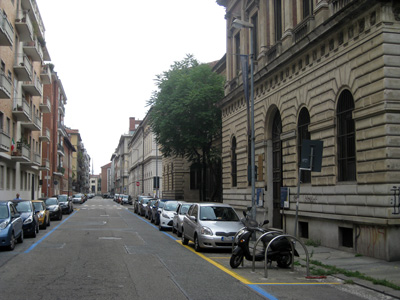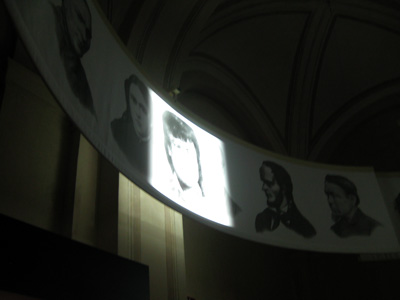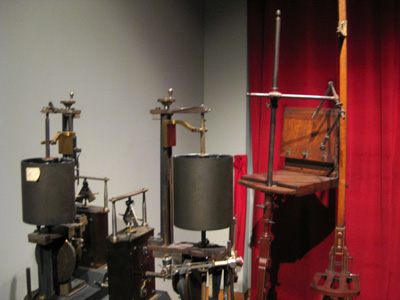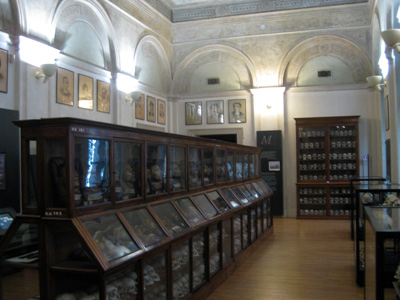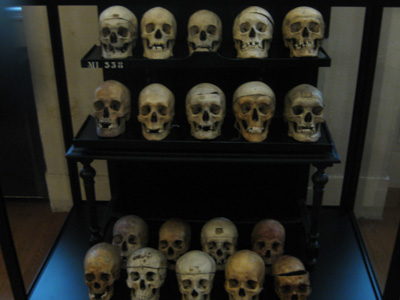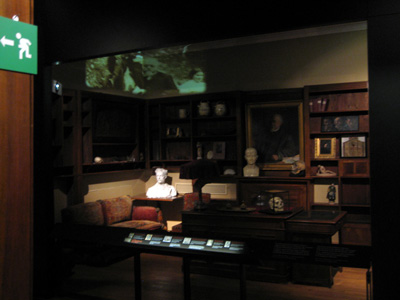Research visit to the “Museo di anthropologica criminale”, the Lombroso Museum for Criminal Anthropology in Turin/Italy, August 2014.
The navigation system leads us into the busy city of Turin in northern Italy, past huge shopping malls and petrol stations, past the derelict illegal housings of migrants, along the river and through the scenic city centre and on to a quieter part of town where the museum occupies a historical university building. The collection was created by the Italian physician and criminologist Cesare Lombroso in 1892 and has continuously existence ever since. It moved back to its former location the “Palazzo degli Instituto Anatomico” and was redone recently, explanations were added and multi-media installations guide the visitor, but the artefacts and the presentation are still in the vein of the famous advocate for positivist criminology.
The in the pompous hallway of the late nineteenth century building that was constructed as a “city of science” a video installation is installed below the ceiling. The inner side of the circular object shows portraits and specimen from the collection, a moving projector throws similar images onto this screen and creates temporary superimpositions of different faces. This introduction to visual material of the collection has striking similarities to the technique of composite photography that was developed as a mode of scientific visualisation by Lombroso’s British contemporary Francis Galton. The installation might also be an illustration of a scientific method, direct visual comparison.
In a dark, wooden furnished cinema-style anteroom a double-screen video installation introduces the time of Cesare Lombroso, the turn of the 19th century. In a staged conversation a younger and an older man reminisce about progress and scientific development; they refer to the words and deeds of Lombroso. Even though the older man seems to be skeptical and mentions the unsuccessful struggle against criminality and mental illness, this debate does not help to re-evaluate the controversial character of the criminologist. It aims to place Lombroso in his temporal surrounding, but it does not mention views and theories that from a current viewpoint are highly problematic, such as atavism and his typology of criminals, even though these were already criticised by parts of the scientific community during Lombroso’s time.
Instruments & Measurements
The actual exhibition starts in a small room that is filled to brim with all kinds of measuring instruments that were used by Lombroso: calipers to measure the human frame, body parts and bones, but also photographic cameras and stereoscopic viewers that were naturally accepted as visual measuring devices. An interesting instrument that I have not come across jet is a so called “craniograph” that was used to produce scull profiles, invented by Paul Brocka and manufactured by A. Moltani in nineteenth century Paris. The instrument reduces three dimensional objects to a two dimensional shape, it produces traces of sculls that are much like silhouettes that were widely produced as “shadow images” before the advent of photography.[1] However, many of the anthropometrical instruments are familiar to me through the collections of Alphonse Bertillon and the instruments of his Bertillonage, as well as the Francis Galton collection and the instruments of the “Anthropometric Laboratory”.
Following his teacher Jacob Moleschott, an advocate for positivism and exact measurement, Lombroso set out to measure and statistically quantify madness, criminality, genius, but in contrast to Galton, he did not invent the instruments, but relied on existing ones. The room also displays Anfosso’s tachyanthropometer, an instrument resembling a chair with all kinds of arms and calipers that could be used to extract eleven measurements from the human body. Lombroso refers to the instrument as “anthropometric guillotine; so quickly and with the precision of a machine, it does give the most important measurements of the body”[2]. This instrument takes up certain anthropometric measurements of the Bertillonage, but leaves out some and adds others, interestingly both work with eleven measurements. Bertillon would have strictly opposed this, he always objected to improvements of his method and cautioned against problems arising from inconsistent methods in the anthropometric measurement for the identification of individuals.
In his book “Crime: its Causes and Remedies” Lombroso argues for the introduction of Bertillon’s method of anthropometric identification[3] and for the establishing of a “well-arranged collection of photographs of criminals”[4]. He proposes to further develop Bertillon’s measurement protocol through an advancement of the tachyanthropometer:
“With this same object the author has constructed and improved „Tachy-Anthropometer,“ a contrivance by which the necessary measurements of the body and skull may be quickly made, and which also permits the lateral, transverse, and horizontal curves of the skull to be taken and recorded automatically by means of an electric pen. This latter system has the great advantage that the procedure is purely mechanical, and that the sources of error are much less numerous than in the regular Bertillon system; and while in the millimetric measurements the only means of verifying their accuracy is to repeat them, where the cranial outlines are taken, their precision can be tested by their direct superposition upon the head of the subject. It should not be forgotten that in the ordinary system the points of difference between individuals are very limited, while in the new system they are very numerous.”[5]
It is fascinating how the same instruments to measure and quantify the human physique could be used to such different outcomes. Bertillon aimed to establish a means to individualise, to establish personal and verifiable identity. Galton and Lombroso were quantifying and typifying groups according to their anthropometric frames.
The work of both scientists’ shows striking similarities: both are captivated by the exact measurement of human physiognomy and are convinced that these outer characteristics are revealing inner dispositions such as criminality, genius, or health. Also Darwinian evolutionary theory and the fear of degeneration informs their thought: while Galton fears a regression in the process of heredity and with eugenics proposes a process of selective breeding to preserve the “quality of a race”, Lombroso’s theory of atavism detects primitive, sub-human stages of development on the bodies of criminals. But at later stages the scientists follow different paths: Galton does not follow his initial ideas on the visibility of criminality in the human face and, in the field of criminology, becomes influential in advocating identification through fingerprints as opposed to the Bertillonage. Lombroso defends his positivist theories on the “criminal man” that become influential in nineteenth and twentieth century and were widely accepted by sociologists and criminologists around the world. Especially in the USA they inspired a number of publications.[6]
Human Collectibles
At the entrance of the next room a skeleton greets the visitor – the mortal remains of the famous criminologist himself. This and the next spacious room show excerpts from the actual collection of Lombroso: 684 sculls and 27 skeletal specimen; 182 human brains; 58 animal sculls and 48 skeletal specimen; 30 animal brains; 24 plaster models of sculls and brains; 24 plaster models of anatomical parts; 502 examples of material evidence of crimes, 80 water pitchers made by prisoners, 42 shackles; 98 objects engraved by prisoners, 88 wax and plaster death masks, 175 objects made by asylum inmates; 437 drawings by asylum inmates, 70 portraits of criminals; more than 1000 photographs of people; 13 pages of handwriting of criminals; 63 drawings of criminals; 68 drawings of tattoos. This list shows that the collection was not designed as a public museum; it could rather be seen as an archive and reference for the studies of criminal anthropology. The historical exhibition architecture is however well designed: the wooden display cases that are clearly made to present the specimen. The collection started in 1876 and saw its first public exhibition in 1884 as part of the “National Exhibition in Turin” and was displayed again at the 1885 “International Penitary Congress” in Rome and at the “Second International Criminal Anthropology Congress” in Paris 1889. After its official foundation in 1892 the “Psychiatry and Criminology Museum” was based in different venues and for the second half of the twentieth century was open to researchers only. In 2009, the year of the centenary of the death of Lombroso, the museum was renovated and (re-)opened to the public.
The collection of wax death masks that sit on the top shelves of the central vitrine were cast of prisoners who died in custody in the 1880’s and 1890’s and were donated in 1906 by Lorenzo Tenchini, an anatomy professor in Parma, Italy. They carry printed signs with numbers, the conviction, printed in bold letters, age, place of birth, province, height, weight of brain, and cephalic index. In the lower shelves a huge number of sculls are displayed, about half are cut open, probably to remove the brain, and most sculls are directly written on. Many carry numbers, names, dates and measurements as well as stickers declaring “Racolta Lombroso” (Lombroso Collection). One scull is inscribed with different points such as “Bregma”, “Ofrion”, “Gonion”, different craniometric points, but also “criminale” written on the side of the scull – possibly a referential specimen. I have come across a similar object in the Rollett Museum in Baden where a real scull was fashioned out as a phrenological guide. Others carry names such as “Elisa Simone, 3. luglio (18)79, Bronchite”; or “Ghiome, 44 ani, 1888, Tuberculosis”, a more recent sign is says: “for some individuals identification is no longer available”. A curious sign, since the specimens were not collected for purposes of identification in the first place, this collection is not about individuals, but about typologies of the criminal scull.
The museum only shows very few examples from the huge collection of photographs that are kept in the non-public archive. The portraits are classical mug shots, frontal and lateral portraits taken in a single exposure by the aid of a mirror. The background is a light cloth and people are photographed in their own clothes. In his studies Lombroso used photographs as direct representation of the person and as a basis for his judgments on criminal types:
“A study of the photographs of criminals allows us […] to fix the frequency of the criminal physiognomic type in the ratio of 25 with a maximum of 36 in murders, a minimum of 6 to 8 in bankrupts, swindlers and bigamists”[7]
Here the photograph alone, a two dimensional representation, not a rigid anthropometric examination, informs the judgment on individual suspects and groups of people such as anarchists and revolutionaries. Probably during the “2nd International Criminal Anthropology Congress” in Paris where parts of the collection were presented, Lombroso visited the photographic archive of the Judiciary Service under Bertillon, where he examined photographs of communards and anarchists and observed a high percentage of criminal types[8].
Epiphanies & Artisanal Expressions
A small somber corridor presents Lombroso’s “moment of epiphany”. A video shows the handling of a human skull in comparison to animal sculls; in a dark corner a small group of skeletons, the remains of 19th century criminals who died in custody silently witnesses the presentation. We listen to Lombroso’s quasi-religious language describing the founding moment of his theory of atavism, when he discovered an irregularity in the head of a deceased prisoner in which he attributed to an evolution in reverse:
“This was not merely an idea but a revelation. At the sight of that skull, I seemed to see all of a sudden, lighted up as a vast plain under a flaming sky the problem of the nature of the criminal—an atavistic being who reproduces in his person the ferocious instincts of primitive humanity and the inferior animals.”[9]
The next room is dedicated to the collection of artistic and artisanal works of prisoners and inmates of lunatic asylums. Here Lombroso assumed the connection between genius and insanity and also believed to have discovered signs of primitivism in the pictorial work of mentally disabled persons, strengthening his theories of different evolutionary levels and atavism. The room is dominated by a series of portraits, forming a frieze just below the high ceiling. These sketches, along with the photographs, the wax and death masks, as well as the sculls hint at how the criminologist treated various modes of representation almost interchangeably. He pronounced his “verdicts” on the criminal nature of individuals on the basis of artistic representations; at some instances he attenuates his judgments by the remark that the portrait might not be true-to-life.
Revisionist Reflections?
The universe of images and specimen that surround Lombroso culminates in the original study of Lombroso that closes tour through the exhibition: busts and bas-reliefs, pottery and paintings, sketches and engravings, plaster casts and sculls that informed his scientific work. The scull of Giuseppe Villella, the central reference for his theory of atavism, silently dominates the desk, resting there during Lombroso’s whole career – and afterlife.
The multi-media show further extends this view with projections to the walls and ceilings and the sound of an imaginary discourse of the criminologist reflecting on his own life and work. Here a posthumous Lombroso refers to his most important ideas and theories. In an apologetic tone he mentions atavism, theories on race, his derogative treatment of women, and a short detour to spritism, retorting to the excuse of science always being provisional. This imaginary self-reflection – and the curatorial reflection of the relatively new public museum – does not question the harsh realities of the prison system and the consequences of positivist criminology, nor the individual destinies, for which Lombroso was partly responsible; it does not question the sexism and racism prevalent in the criminologist’s work. This final presentation links back to the beginning of the tour, where criticism was deked, rather than seriously expressed. Is that to safe the reputation of the renowned son of Turin, or are there more serious concerns related to a celebration of Northern Italian superiority over Southern Italy, as some comments on the internet suggest? In any case, from a science-historical perspective the uncritical attitude of the museum presentation is striking, and I doubt that the museum will achieve its goal of “teaching caution […] in interpreting the results of science” as the museum guide proposes. A chance was missed in 2009 to bring the collection into the twenty-first century.
[1] The instrument was described in: Lombroso, Cesare: Les applications de l’anthopometrie criminelle. Paris: Félix Alcan, 1892, 203-209.
[2] Lombroso, Cesare: „Illustrative Studies in Criminal Anthropology.“ Quoted in: Kelly Hurley: “The Gothic Body. Sexuality, Materialism, and Degeneration at the Fin de Siecle.” Cambridge: Cambridge UP, 1996, 100.
[3] Lombroso, Cesare: Crime: It’s Causes and Remedies. Boston: Little, Brown, and Company, 1918, 251f.
[4] Lombroso, Cesare: Crime: It’s Causes and Remedies. Boston: Little, Brown, and Company, 1918, 250.
[5] Lombroso, Cesare: Crime: It’s Causes and Remedies. Boston: Little, Brown, and Company, 1918, 253.
[6] See: Maxwell, Anne: Picture Imperfect: Photography and Eugenics, 1870-1940. Brighton, Portland: Sussex Academic Press, 2008, 62.
[7]Cesare Lombroso (1884) quoted in: P. Bianucci et al.: Cesare Lombroso. Museum of Criminal Anthropology. University of Turin. Visitors Guide, 30.
[8]See : Lombroso, Cesare: Les applications de l’anthropologie criminelle. Paris : Felix Alcan, 1892, 5. “Et ce type [criminelle] se répète avec fréquence chez les communards et chez les anarchistes. Sur 50 photographies de communards, j’ai trouvé le type criminel dans la proportion de 12 p. 100; le type des fous chez 10 p. 100. Sur 41 anarchistes de Paris, que j’ai étudiés à la préfecture de police de Paris, chez M. Bertillon, la proportion du type criminel était de 31 p.”
[9] Sawyer F. Sylvester, introduction to Cesare Lombroso, “Criminal Man,” (1876) in: Sawyer F. Sylvester, Jr. (ed.): “The Heritage of Modern Criminology.” Cambridge, MA: Schenkman Publishing, 1972, 63.


